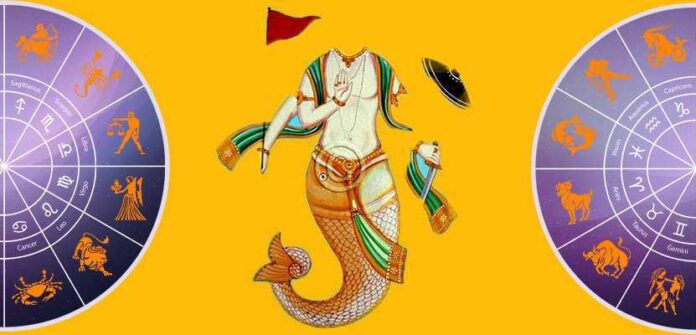Ketu represents the subtle energies that allow us to either transcend our karma or have to face the most powerful and dangerous karmas within us, either individually or collectively. Ketu is the Sanskrit name for the south node of the Moon, called the Dragon’s Tail in western astrology or the tail of the serpent in Vedic astrology. It is always opposite in the zodiac to Rahu, the north node of the Moon, the Dragon’s head or serpent’s head in Vedic astrology. Rahu and Ketu are not actual planets but they have such powerful influences astrologically that they are regarded as half-planets or shadow planets. Along with Sun, Moon, Mercury, Venus, Mars, Jupiter and Saturn they make up the nine planets or Navagraha of Vedic astrology.
By Dr David Frawley
Astronomically speaking Rahu and Ketu mark the nodes of the Moon or the points in the zodiac where eclipses of the Sun and Moon can occur. When the New Moon occurs in conjunction with one of the nodes a solar eclipse occur. When the full Moon occurs in conjunction with one of the nodes, a lunar eclipse occur. There are usually two sets of eclipses every year around six months apart. The nodes are not fixed but move backward in the zodiac in a 18.6 year cycle. The Moon takes 27 days to return to the same node.
Though either node can cause eclipses of either the Sun or the Moon, Vedic astrology looks at Ketu more in terms of the symbolism of an eclipse of the Sun and Rahu in terms of an eclipse of the Moon. In other words, Ketu can be more powerful than the Sun or have the power to eclipse or negate it.
Vedic astrology ascribes to Rahu a predominately Saturnian influence of a subtle nature, though with some shades of Mercury and Venus. It causes mental, emotional and nervous disorders at a personal level, and at a collective level mass confusion, media distortions, epidemics and illusions. Yet on the positive side it can provide fame, healing powers and good karma.
Powerful Ketu
Ketu is given a predominantly Mars influence of a subtle nature, though with some shades of Saturn. It causes wrong judgment, self-negativity, isolation, injury and poisons at a personal level, and at a collective level wars, revolutions, narrow, constricted or fanatic views. At a collective level today Ketu also represents mathematics, computers, research and technology, while Rahu represents the media, entertainment and the ability to influence the masses.
At the highest level Ketu gives spirituality, liberation and psychic insight including astrology and is the most important planet in the chart for indicating Self-realization. Ketu can be regarded as the most powerful, occult and spiritual influence in the chart. It is sometimes called the “terminator “as it brings things to an end. Ketu has a power of negation, which at the most extreme personal level is suicide and at the highest spiritual level is the liberation from body and mind or Nirvana. Ketu can show physical or psychological negation or death, or transcendence to a higher reality.
Yet Ketu is a powerful force that few individuals can master in order to benefit from its higher dimensions, which require spiritual practice and sadhana. Both nodes make up the Kundalini Shakti or serpent’s power, with Ketu as its perceptive force and Rahu as its creative force.
Ketu Takes us Beyond the Mind
Ketu is symbolized as a headless serpent is then given a new head, which is sometimes that of the entire cosmos. As such Ket uis connected to deities who have their head cut off and replaced, like Ganesha, who is given the head of an elephant or the Goddess Chhinnamasta who drinks her own blood with her severed head that she carries in her hands. Such harsh symbols reflect transcendence of physical reality.
Ketu gives inner powers of knowing, to see without an eye, hear without an ear, or breathe without the breath. Ketu is the indicator of great Yogis and sages at the highest level, including the opening of the third eye and crown chakras. Yet at a lower collective level Ketu indicates the forces of conflicting beliefs and values that lead to violence and conflict, stirring powerful subconscious emotions.
Ketu certainly can bring out narrow, fundamentalist and even violent beliefs, along with military action. It can cause self-destruction. Yet it can also bring in new insight, either at a scientific or technological level, or at a spiritual level of self-negation and a higher Self-realization.
Article Courtesy : www.vedanet.com












